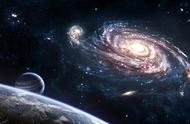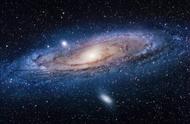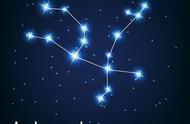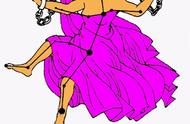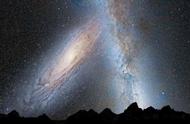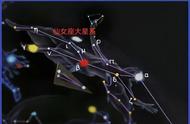
在希腊神话中,安德洛墨达(Andromeda,古希腊语:Ἀνδρομέδα)是衣索比亚(Aethiopia原指尼罗河上游地区,即在现今的埃塞俄比亚境内,Ethipopia就是由Aethiopia演化而来)国王塞菲俄斯(Aethiopian King Cepheus 现今的英文含义是仙王座)和他的妻子卡西俄珀亚(Cassiopeia现含义仙后座)的女儿,即衣索比亚公主。话说衣索比亚公主长得非常美丽,她的母亲傲慢地说她比所有的海中神女都美,因而触怒众海中神女。与此同时海神波塞冬(Poseidon,众神之王Zeus宙斯的兄弟)受到冥王哈迪斯(Hades,宙斯的另一个兄弟)谗言的影响,决定派遣海怪希徳斯(Cetus现含义鲸鱼座)蹂躏整个衣索比亚地区作为神的惩罚。为此,Andromeda被剥光衣服赤裸裸的被用锁链拴在海岸边一块岩石上作为祭品献给海怪,但碰巧珀耳修斯Perseus(英仙座)经过此地,将她救出,之后两人成为夫妻。仙女座的传说由此而来。再加多一句,漫画《圣斗士星矢》的作者车田正美对希腊神话相当的有研究,因此仙女座瞬的圣衣才会被设计成使用锁链,赞一个。
言归正传,仙女星系Andromeda是距离我们银河系最近的星系,也被称为梅西耶31,M31,或NGC 224,是一个螺旋星系,距离地球约780 kiloparsecs(250万光年)。这是距离银河系最近的主要星系,用古希腊神话传说中的仙女Andromeda命名,古文献中被称为仙女座大星云。仙女座星系被相信是本星系群中最大的星系,直径约20万光年,外表颇似银河系。本星系群的成员有仙女星系、银河系、三角座星系,还有大约44个小星系。
仙女座星系是本地星系团中质量最大的星系。尽管早期的研究结果认为银河系中含有较多的暗物质所以可能是本地星系团中最庞大的星系,但在2006年斯皮策太空望远镜发现仙女座包含一个万亿颗恒星(10的12次方):至少是银河系所含恒星数量(估计为2000-4000亿)的两倍。
仙女座星系估计为1.5×10^12个太阳质量,而银河系的质量估计为8.5×10^11个太阳质量。相比之下,2009年的一项研究估计,银河系和M31是大致相等的质量,而2006年的研究认为银河系的质量约为仙女座质量的80%。银河系和仙女座预计在37.5亿年后碰撞,最终合并,形成一个巨大的椭圆星系或者一个大磁盘状星系。
仙女座星系的可视星等值是3.4,是夜空中最亮的天体之一,在没有月亮的夜晚,即便该地区有中度光污染也可用裸眼看见。虽然用较大的望远镜拍摄到的仙女座宽度超过六倍宽的满月,但在用肉眼、双筒望远镜或小型望远镜观测时只有中央区域明亮可见。
本期内容献给所有爱好star gazing的小伙伴们,我们都是星辰的后裔,仰望星空就是在仰望我们的祖先。
In Greek mythology, Andromeda is the daughter of the Aethiopian king Cepheus and his wife Cassiopeia. When Cassiopeia's hubris leads her to boast that Andromeda is more beautiful than the Nereids, Poseidon, influenced by Hades, sends a sea monster, Cetus, to ravage Aethiopia as divine punishment. Andromeda is stripped and chained naked to a rock as a sacrifice to sate the monster, but is saved from death by Perseus.
The Andromeda Galaxy, also known as Messier 31, M31, or NGC 224, is a spiral galaxy approximately 780 kiloparsecs (2.5 million light-years) from Earth. It is the nearest major galaxy to the Milky Way and was often referred to as the Great Andromeda Nebula in older texts. It received its name from the area of the sky in which it appears, the constellation of Andromeda, which was named after the mythological princess Andromeda. Being approximately 220,000 light years across, it is the largest galaxy of the Local Group, which also contains the Milky Way, the Triangulum Galaxy, and about 44 other smaller galaxies.
The Andromeda Galaxy is the most massive galaxy in the Local Group as well. Despite earlier findings that suggested that the Milky Way contains more dark matter and could be the most massive in the grouping, the 2006 observations by the Spitzer Space Telescope revealed that Andromeda contains one trillion (10^12) stars: at least twice the number of stars in the Milky Way, which is estimated to be 200–400 billion.
The Andromeda Galaxy is estimated to be 1.5×10^12 solar masses, while the mass of the Milky Way is estimated to be 8.5×10^11 solar masses. In comparison, a 2009 study estimated that the Milky Way and M31 are about equal in mass, while a 2006 study put the mass of the Milky Way at ~80% of the mass of the Andromeda Galaxy. The Milky Way and Andromeda are expected to collide in 3.75 billion years, eventually merging to form a giant elliptical galaxy or perhaps a large disk galaxy.
At 3.4, the apparent magnitude of the Andromeda Galaxy is one of the brightest of any Messier objects, making it visible to the naked eye on moonless nights even when viewed from areas with moderate light pollution. Although it appears more than six times as wide as the full Moon when photographed through a larger telescope, only the brighter central region is visible to the naked eye or when viewed using binoculars or a small telescope.
Today's article is for all the star gazing fans, every time we look at the stars, we are looking right at our ancestor.
,